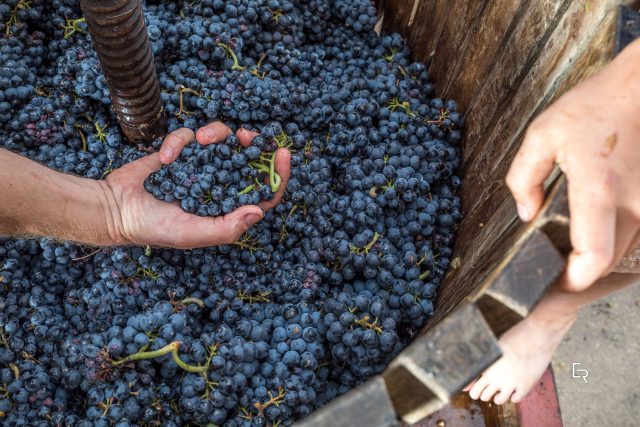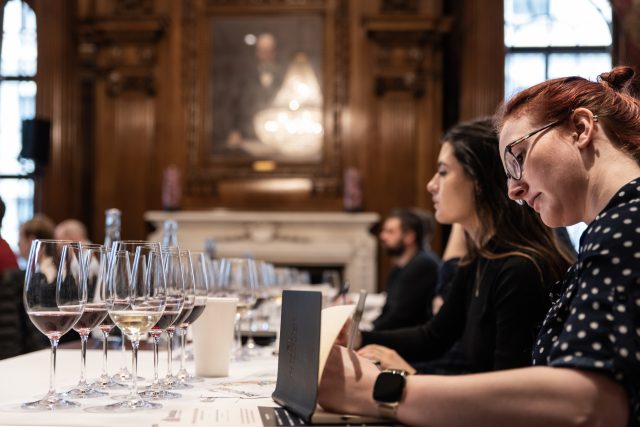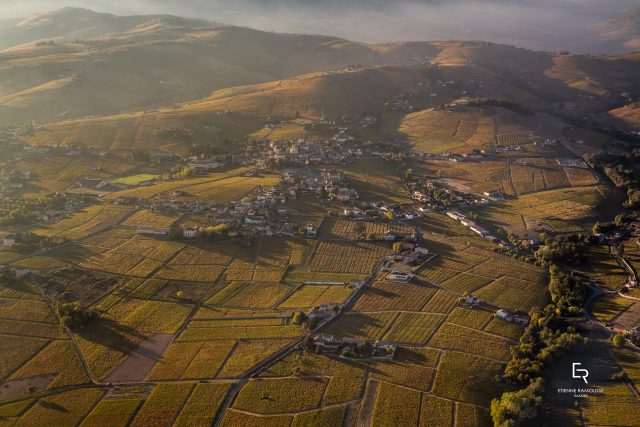This website uses cookies so that we can provide you with the best user experience possible. Cookie information is stored in your browser and performs functions such as recognising you when you return to our website and helping our team to understand which sections of the website you find most interesting and useful.
A new generation showcases Beaujolais’ potential
db reports on a recent London masterclass, where a new wave of producers made the case for Beaujolais’ potential on the current market.

Exciting progress is under way in Beaujolais. At a recent masterclass, hosted by Patrick Schmitt MW, the UK wine trade was treated to a look at the young producers driving it ahead.
In the presentation, billed as ‘8 From 8: Discover 8 Faces of Gamay’, he presented a context for the wines and the reasons for their strong market potential. He then hosted a tasting of eight expressions from the region, each from a winemaker with eight or fewer vintages behind them. db joined the tasting to discover the new generation pushing Beaujolais forward.
A regional heritage
Looking to the region’s future was the overall aim of the masterclass, but Schmitt began by rooting his comments in its past. Beaujolais producers have a rich inheritance, which encompasses regional traditions, complex geography and a signature grape variety.
Introducing the masterclass, Schmitt established a winning formula that can summarise Beaujolais: “One place, one grape”. The simplicity of the proposition, which enables producers to establish variations on a common theme, has been hugely advantageous to producers making Malbec in Mendoza, for example, or Sauvignon Blanc in Marlborough. As a closer parallel, he highlighted the international success of Chablis, which has built a strong international brand for high-quality French wines on the basis of a single flagship grape. Beaujolais, with its long history and distinctive landscape has struck on a similar commercial opportunity with Gamay.

Although many associate Beaujolais with the 1980s vogue for Beaujolais Nouveau, the region has centuries of winemaking history. Records of the activity stretch as far back as Roman rule in the 3rd century AD, even if the grape variety grown at that time is unknown. The story, for many years, was one of sporadic production, interrupted by conflict and seldom exported beyond the locality. However, the Beaujolais region had the potential for expansion, and realised this in the 17th century. As its nearby rivers boosted trade and local wealth, Beaujolais could look beyond its own villages to distribute its wines. First in the ‘bouchon’ restaurants of Lyon and then further afield, the region’s winemakers began the expansion that laid the foundations for today’s growth.
As well as a winemaking tradition, Beaujolais’s new generation of producers has inherited a landscape ideal for winemaking. The network of hills, valleys and outcrops in the south of Burgundy has a wide range of sites suitable for vineyards. They are differentiated by geology, but bound by a shared relatively warm, continental climate. Schmitt attested to the dramatic landscape with a cycling anecdote. The tough steep slopes, the refreshingly cool breezes and the striking vistas, he said, are rewarding both for the cyclist and the vigneron.
The region is not, however, homogenous. It encompasses 12 appellations d’origine contrôlée (AOCs), which provide diversity both in style and in market position. Beaujolais AOC covers the entire production area, though the majority of the wine comes from the region’s south and is the lightest in character. Beaujolais-Villages AOC represents a smaller area in the north, dominated by some of the region’s steepest slopes. Additionally, there are 10 cru-level ACs, with each representing a distinctive commune. These vary substantially, but are small enough to have distinct identities. Juliénas AOC, for instance, sits on steep slopes of blue rocks and makes fleshy wines. Fleurie AOC, on the other hand, is dominated by pink granite and is known for the delicacy of its wines.
The sites are bound by a dominant grape variety: Gamay Noir à Jus Blanc (to use its full name). Although some Beaujolais Blanc is made using Chardonnay, and Gamay can produce rosé, 95% of production is Gamay red wine. Schmitt highlighted the grape’s lineage as some indication of its prospects. Its parents, Pinot Noir and Gouais Blanc, represent two sides of the grape. On the one hand, the prestige of Pinot Noir speaks to Gamay’s high-quality potential. On the other, Gouais Blanc is known for its high yields, hinting at Gamay’s potential for commercial success without a high price tag. As the signature variety of the region, it offers dynamic producers plenty of opportunities, both in their businesses and in their winemaking.
Meeting modern tastes
The wines of Beaujolais, though rooted in this substantial heritage, are increasingly seen as a modern face of French wine. Indeed, throughout the masterclass, Schmitt made numerous references to their consumer appeal. In questions of style, prestige, accessibility and sustainability, the new generation of Beaujolais producers have aligned their wines with key market trends.
At the most fundamental level, Beaujolais is meeting modern consumer tastes. The region is making wines with the aromas and structure that wine lovers increasingly seek out. Although the current market allows for many styles to thrive, Schmitt highlighted that lighter, refreshing and fruit-forward reds are increasingly popular, and that is a profile that Beaujolais matches. Gamay is naturally inclined towards bright aromas of red fruits, both sweet and crunchy, as well as the balanced acidity that keeps the wines refreshing. Moreover, the region’s hilly vineyards naturally offer the altitudes and aspects necessary to create bright, lively wines. Beaujolais has the assets to combine elegance, complexity and accessibility.
The new cohort of Beaujolais producers has inherited those longstanding advantages, albeit in a market that plays to the wine’s strengths. Yet they are also actively shaping the style, making decisions in the winery that showcase their crop. Schmitt highlighted the fact that winemakers increasingly have experience working abroad. Working in different regions, for instance with Pinot Noir in Marlborough, gives them an international perspective on the current market and experience with a range of grape varieties and styles.
The outward-looking approach is also shown in the use of technology. Although carbonic maceration, a technique associated with Beaujolais for decades, is widely used to craft fruit-forward wines, that is far from the only intervention. Several producers, for instance, are using concrete tanks to age their wines. The non-traditional containers avoid imparting overt flavour in the way that oak might. However, they have a benefit of providing micro-oxygenation, a safeguard against the reductive aromas that Gamay is prone to. In these choices, the new generation is creating Beaujolais for the modern market.

Indeed, modern Beaujolais producers are striking a careful balance between contemporary appeal and a prestige built on their heritage. Many in the region now refer to the top wines as ‘nouveaux grands vins du terroir’. The term suggests the traditional terroir-focused ‘grands vins’ of regions such as Burgundy or the northern Rhône, but with a modern tilt. It is no coincidence that the eight wines featured at the masterclass represented a number of appellations and sites: like many of France’s most iconic wines, Beaujolais cuvées remain led by unique terroirs. They are, however, representative of a new wave of wines, offering broad appeal to drinkers.
Unlike some other prestigious French regions, Beaujolais recognises accessibility as a key part of its appeal. Wine is shedding much of its cultural baggage, in part because of the growing trend for lighter, fresher wines. It is no longer a beverage exclusively to be consumed with formal meals or on special occasions. Instead, wines are being drunk as aperitifs, and paired with various cuisines. To do so, wines need to be accessible both in style and in price.
On the first point, Beaujolais is emerging as a versatile performer that the average consumer can easily enjoy. The wines, given Gamay’s flavour profile, are ideal for drinking young. Most Beaujolais will show its character well in the first two years after harvest. Although many can age well – structured examples from Morgon and Moulin-à-Vent, for instance – the ageing process is not essential for Beaujolais wines to show their best. Given that most consumers have neither the budget nor the facilities to age wines, Beaujolais can offer high-quality wines without intimidating drinkers.
On price too, accessibility is key. Schmitt was keen to promote Beaujolais’s great value. Thanks to the region’s appellation structure, it offers options that range from inexpensive Beaujolais AOC wines to renowned examples from a single cru. Though Beaujolais will never wish to supplant the cheapest bottles at the supermarket, it still offers keen value for terroir-driven wines. When exemplary wines are sold at around the £20 price point, the world of fine French wine suddenly becomes less intimidating to the average consumer.
Indeed, as further proof of the region’s terroir-led quality, Beaujolais producers are banding together to submit candidate vineyards for elevation to premier cru status. The collective initiatives, which have been driven by the winemakers in their respective crus, have evaluated soils and wines to propose lieux-dits for promotion. The classification, based on tastings, value and both historical and contemporary renown, would further cement Beaujolais’s quality in the mind of the consumer. Two crus, Brouilly and Fleurie, have submitted proposals in the last year alone. Those vineyards, 16 in Brouilly and seven in Fleurie, would be subject to stricter regulations such as lower yields and longer ageing, and would champion premium wines from the region.
As a final consideration for the current market, Schmitt returned repeatedly to the notion of sustainability. In this, the new generation is following a distinguished inheritance. The region has a reputation for pioneering work in sustainability, encompassing respect for the land and carefully considered viticulture. The Terra Vitis association, for instance, was created in Beaujolais in 1998 and is France’s only national certification for sustainable winegrowers. More recently, Beaujolais has seen an explosion in organic certification, with the number of certified organic estates jumping from 100 to 150 between 2015 and 2020.
These figures are emblematic of a thread that ran through the masterclass. Whether expressed through careful individual labour, official third-party certification or experimentation with low-intervention winemaking, Beaujolais producers are showing a continued approach to sustainability. Although not a new focus in the region, it is a powerful pull for consumers seeking ethically-made wines. Indeed, as greater scepticism over green-washing creeps into consumer consciousness, the young producers of Beaujolais can point to decades of pioneering work in sustainability. This is not a new fad that they have awkwardly inserted into their practice. Rather, sustainability is fundamental to the region’s identity.
Emblematic wines
The tasting that concluded the event was a true celebration of Beaujolais’ potential. With only eight wines presented, they were selected as ambassadors for the entire region and as displays of individual winemaking. The eight expressions highlighted different terroirs, styles and prices, but were bound by the dynamism of their producers and the approachability of the wines.
The tasting opened with a rarity: a Chardonnay from Clos du Vieux Bourg that illustrated the potential of Beaujolais Blanc. Schmitt was keen to emphasise its untapped potential, likening it to the gradual appearance of white Rioja in UK gastropubs. Combining the authority of a well-known region with the interest of an unusual style, Beaujolais Blanc is an interesting niche in the market.
This was followed by three classically-styled reds. The Beaujolais-Villages from Château de Pougelon showcased value, purity and prettiness representative of the larger appellation. Then the Beaujolais Pierres Dorées from Domaine des Prévelières showed a youthful, juicy expression that still has potential for ageing, while the Regnié from Domaine de Colette showed lightness, but also a concentrated intensity gained through old vines and green harvesting.
The Brouilly from Domaine des Roches Bleues offered a new perspective. Like the previous three reds, it is made organically, but also uses native yeasts and minimal SO2. The result combines Gamay’s fresh red aromas with complex, rich notes from natural fermentation.

The final three wines showcased three crus. The Fleurie from Domaine Grégoire Hoppenot combines two lieu-dit sites for a fresh and light-bodied red that delicately displays the cru’s floral qualities. For Schmitt, it also illustrated a bigger advantage of Beaujolais: the wines can show light, bright character without thinness. The Moulin-à-Vent from Domaine Elisa Guerin then showed intensity, with a touch of smoke demonstrating Beaujolais’ suitability for barrel contact. The tasting concluded with a structured, complex Morgon from Château Bellevue that proved the region’s wines can still show richness and weight.
Schmitt drew several links between producers – an understanding of the region’s heritage, a respect for their land and a consumer-friendly style. Yet he best summarised their shared approach as an attitude: “A young generation declaring: ‘I want to preserve the soils,’ whose motivation is to make the best possible wine.” It speaks of their commitment to land and tradition, but also to quality and accessibility. As a manifesto for Beaujolais’ new generation, you could certainly do a lot worse.

